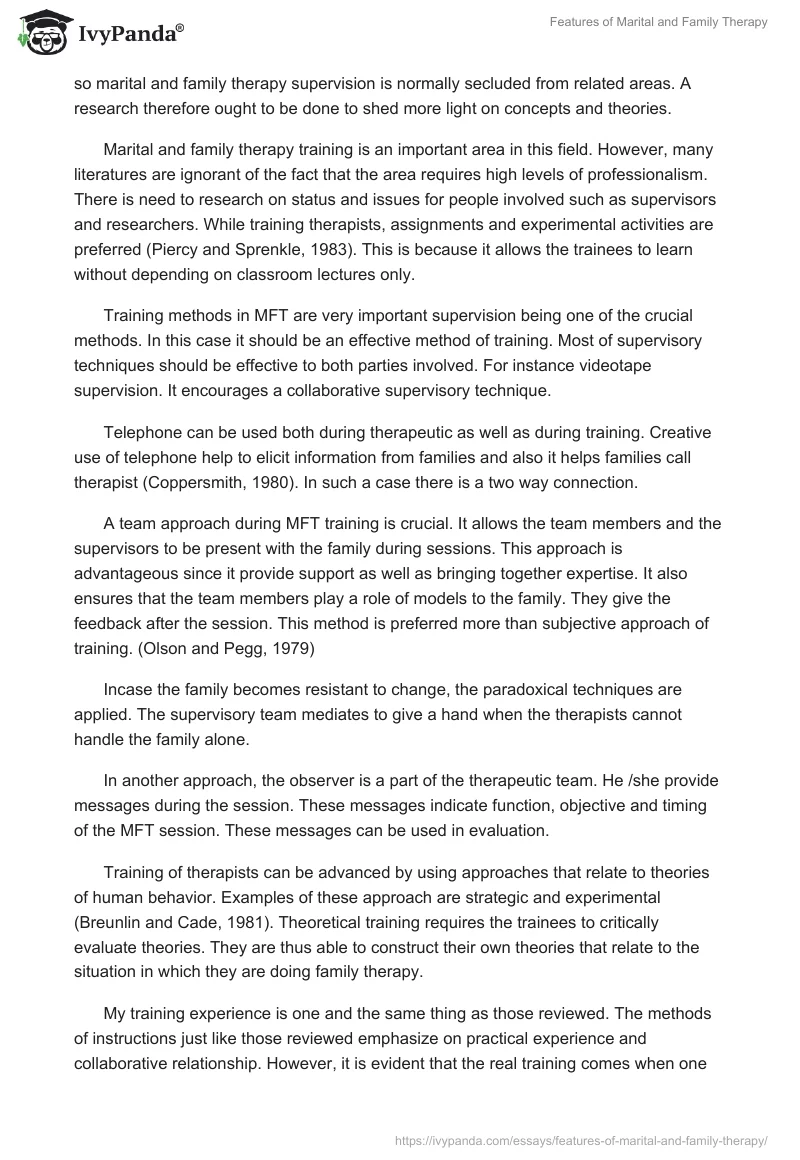Introduction
Marital and family therapy (MFT) is a field that deals directly with families. It is aimed at managing change and development in a family. This is because these are key areas in which the people in a family interact. In training the marital and family therapists therefore, it is important to emphasize on approaches that will yield effective family therapy outcomes. Marital and family therapy field touches all human dilemmas. It addresses all kinds of relationships and psychological conflicts that may arise as a result of these relationships. In the marital and family therapy field, people can be trained to be trainers, therapists, supervisors as well as researchers. The training, methods should exhibit present knowledge in the field. (Piercy and Sprenkle, 1983).)
Training Of Marital and Family Therapists Review
Training in this field should be based on three main domains. These include theory, research and practice. Trainees in this field are encouraged to use their own original approaches rather than using traditional clinical approaches. Training marital and family therapists differs from one institution to another. Training theories advance with time. Initially the original approaches were based on field experience in which the trainees are expected to learn more about family therapy by doing it practically. These were followed by structural and strategic approaches. The third approaches emphasize on experiments, communication and behavior change. The modern approaches are neo-analytic and trans-generational (Cleghorn and Levin 1973). From this advancement in the approach it can be concluded that the methods advance as a result of more research that indicate the need for a more modern MFT.
During training, supervision should be emphasized. However it has been studied that although supervision has always been considered during training, there is no enough literature about it. People training cannot learn more about the process. More so marital and family therapy supervision is normally secluded from related areas. A research therefore ought to be done to shed more light on concepts and theories.
Marital and family therapy training is an important area in this field. However, many literatures are ignorant of the fact that the area requires high levels of professionalism. There is need to research on status and issues for people involved such as supervisors and researchers. While training therapists, assignments and experimental activities are preferred (Piercy and Sprenkle, 1983). This is because it allows the trainees to learn without depending on classroom lectures only.
Training methods in MFT are very important supervision being one of the crucial methods. In this case it should be an effective method of training. Most of supervisory techniques should be effective to both parties involved. For instance videotape supervision. It encourages a collaborative supervisory technique.
Telephone can be used both during therapeutic as well as during training. Creative use of telephone help to elicit information from families and also it helps families call therapist (Coppersmith, 1980). In such a case there is a two way connection.
A team approach during MFT training is crucial. It allows the team members and the supervisors to be present with the family during sessions. This approach is advantageous since it provide support as well as bringing together expertise. It also ensures that the team members play a role of models to the family. They give the feedback after the session. This method is preferred more than subjective approach of training. (Olson and Pegg, 1979)
Incase the family becomes resistant to change, the paradoxical techniques are applied. The supervisory team mediates to give a hand when the therapists cannot handle the family alone.
In another approach, the observer is a part of the therapeutic team. He /she provide messages during the session. These messages indicate function, objective and timing of the MFT session. These messages can be used in evaluation.
Training of therapists can be advanced by using approaches that relate to theories of human behavior. Examples of these approach are strategic and experimental (Breunlin and Cade, 1981). Theoretical training requires the trainees to critically evaluate theories. They are thus able to construct their own theories that relate to the situation in which they are doing family therapy.
My training experience is one and the same thing as those reviewed. The methods of instructions just like those reviewed emphasize on practical experience and collaborative relationship. However, it is evident that the real training comes when one is in the field. That is, the fundamentals required by the therapists are only acquired once the therapist is employed.
Conclusion
Marital and family therapy in relation to training is highly influenced by many approaches and theories. The choice of the approach has become complicated regarding which is the most effective in training the therapists. There are three methods of instructions that are widely preferred. First, there is Classroom lecture in which theories and practical experiments are used. Secondly, training by forming discussion groups combined with demonstrative videotapes. Finally, field experimental task is an effective training approach. The training method of the therapists should be based on the most effective approach.
References
Breunlin, D. & Cade, B. (1981). Intervening In Family systems With Observer Messages. Journal of Marital and Family Therapy, 7, 453-460.
Coppersmith, E. (1980). Expanding Uses of the Telephone in Family Therapy. Family Process, 19, 411-147.
Cleghorn, J. & Levin, S. (1973). Training Family Therapists by Setting Instructional Objectives. American Journal of Orthopsychiatry, 43, 439-446.
Olson, U. & Pegg, P. (1979). Direct and Open Supervision: A Team Approach. Family Process, 18, 463-469.
Piercy, P. & Sprenkle, D. (1983). Ethical, Legal and Professional Issues In Family Therapy. A Graduate Level Course. Journal of Marital and Family Therapy, 9, 393-401.


